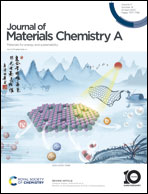Thermo-regulating mesoporous semi-rigid metal–organic–polymer frameworks for controllable adsorption and confinement†
Abstract
In nature, most living organisms are mesoscopic complex assemblages of soft and hard anisotropic blocks, featuring both outstanding mechanical performances and functional adaptability. A similar design also endows mesoporous metal–organic frameworks with limited flexibility but lacks specific stimulus-responsiveness and selectivity. So we introduced for the first time poly(acrylamide-co-acrylonitrile) (P(AAm-co-AN)) with upper critical solution temperature UCST into a conventional metal–organic framework (MOF) by a one-pot method, to construct a “living” metal–organic–polymer framework (MOPF) based on multiple coordination and dipolar interaction. The 3D “brick-and-mortar” MOPFs comprising rigid regular nanorods and amorphous flexible polymeric linkers exhibit attractive thermal responsiveness. Under thermal induction, the reversible interchain transition P(AAm-co-AN) brought about obvious variation in inner pore size. The confinement effect caused by pore variation further affects CO2 adsorption and aggregation-induced emissions. This thermo-regulatable confinement effect of “semi-rigid” MOPFs provides a novel, facile, and promising strategy of physicochemical manipulation for controllable substance loading.



 Please wait while we load your content...
Please wait while we load your content...